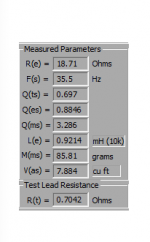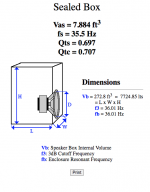Hello everyone,
I'm beginning to build some custom speakers with some drivers I have lying around. First up are some Cerwin Vega 15" woofers. These likely came out of an old concole. I've run the T/S parameters using a DATS V3 and now I'm running them through an enclosure calculator. It's saying 272 cubic feet! Any ideas on what might be wrong? Any help is appreciated. See below. Thanks.
I'm beginning to build some custom speakers with some drivers I have lying around. First up are some Cerwin Vega 15" woofers. These likely came out of an old concole. I've run the T/S parameters using a DATS V3 and now I'm running them through an enclosure calculator. It's saying 272 cubic feet! Any ideas on what might be wrong? Any help is appreciated. See below. Thanks.
Attachments
I'm sorry for my ignorance, but I don't know what you mean...Hi, it could be Vb = Vas , so you are 3 orders of magnitudes away!
I used cubic feet for everything. I've found that it's the Qts variable that's causing huge swings in enclosure size. I reduced it down to .5 and got a much more sane reading of 9 cubic feet. I'd say the biggest problem I'm having is that my DATS V3 is all over the place. Every time I run a free air measurement, I'm getting wildly different readings for these parameters. Hard to tell what's accurate and what's not.Check ' liters' or ' cubic feet ' for units of first entry on calculator ?
If I recall... In a closed box a speaker having X Vas, the volume can be the same as Vas. Vas is the volume of air confined in the cylinder axyal to the cone (speaker's cone... do tweeters have Vas?)... The S should mean Static... Some weight expressed in Newtons should appear in the equation. So the driver in closed box in static condition has some resistance to the atmospheric pressure. OK, I'm done for the Vas...I'm sorry for my ignorance, but I don't know what you mean...
Now for the Qts...
All the 'numbers' are denominator, being 1 at the nominator in the division
Greets!
What model # for future reference and is [Re] really 18.71 ohms, i.e. from back in the low power/impedance matching7.2 tube amp of days gone by?
Note this impacts the driver's effective Qts [Qts'], so can't do an accurate box alignment without it, especially if driven with a high output impedance:
[Qts']: [Qts] + any added series resistance [Rs]: http://www.mh-audio.nl/Calculators/newqts.html
[Rs] = 0.5 ohm minimum for wiring, so may be higher if a super small gauge is used as a series resistor plus any added resistance from an XO/whatever.
Regardless, the usual goal is a T/S max flat [~0.707 Qtc] sealed alignment, which means that with a [Qts/Qts'] near enough =/> ~0.707 = a true infinite baffle since you would have to physically reduce its [Vas] and/or [Qts] spec to make it < [Vas] and why the program defaulted to it since it's the smallest cab it can be per its specs [sealed box math]: https://www.ajdesigner.com/phpsubwooferclosed/constant_equation.php#ajscroll
What model # for future reference and is [Re] really 18.71 ohms, i.e. from back in the low power/impedance matching7.2 tube amp of days gone by?
Note this impacts the driver's effective Qts [Qts'], so can't do an accurate box alignment without it, especially if driven with a high output impedance:
[Qts']: [Qts] + any added series resistance [Rs]: http://www.mh-audio.nl/Calculators/newqts.html
[Rs] = 0.5 ohm minimum for wiring, so may be higher if a super small gauge is used as a series resistor plus any added resistance from an XO/whatever.
Regardless, the usual goal is a T/S max flat [~0.707 Qtc] sealed alignment, which means that with a [Qts/Qts'] near enough =/> ~0.707 = a true infinite baffle since you would have to physically reduce its [Vas] and/or [Qts] spec to make it < [Vas] and why the program defaulted to it since it's the smallest cab it can be per its specs [sealed box math]: https://www.ajdesigner.com/phpsubwooferclosed/constant_equation.php#ajscroll
At such tiny power signals, any stiction can make huge differences, so need to run it in hard/long enough for it to smooth out or highlight any mechanical issues of ancient/abused, etc., drivers; ditto room variables, how the driver is anchored, etc.. Note too that many folks have problems with the Vas spec, which tend to disappear once the pioneer's requirement to raise its Fs 1.56x in a sealed box, so ideally need to lower it 1.56x using mass loading.I used cubic feet for everything. I've found that it's the Qts variable that's causing huge swings in enclosure size. I reduced it down to .5 and got a much more sane reading of 9 cubic feet. I'd say the biggest problem I'm having is that my DATS V3 is all over the place. Every time I run a free air measurement, I'm getting wildly different readings for these parameters. Hard to tell what's accurate and what's not.
Yes, these are very old Cerwin Vega 153s. I believe they were used in tube consoles.Greets!
What model # for future reference and is [Re] really 18.71 ohms, i.e. from back in the low power/impedance matching7.2 tube amp of days gone by?
Note this impacts the driver's effective Qts [Qts'], so can't do an accurate box alignment without it, especially if driven with a high output impedance:
[Qts']: [Qts] + any added series resistance [Rs]: http://www.mh-audio.nl/Calculators/newqts.html
[Rs] = 0.5 ohm minimum for wiring, so may be higher if a super small gauge is used as a series resistor plus any added resistance from an XO/whatever.
Regardless, the usual goal is a T/S max flat [~0.707 Qtc] sealed alignment, which means that with a [Qts/Qts'] near enough =/> ~0.707 = a true infinite baffle since you would have to physically reduce its [Vas] and/or [Qts] spec to make it < [Vas] and why the program defaulted to it since it's the smallest cab it can be per its specs [sealed box math]: https://www.ajdesigner.com/phpsubwooferclosed/constant_equation.php#ajscroll
OK, no joy finding any history beyond it's still a model #, so any labels, other markings on it? Also, what diameter did you use for the Vas measurement as the old pics I found implied a wider surround ctc diameter than modern drivers.Yes, these are very old Cerwin Vega 153s. I believe they were used in tube consoles.
Historically, 16-60 Hz is the sub bass BW, which this driver meets 😉: https://alexiy.nl/eq_chart/So not proper a 'subwoofer'
Nowadays we ideally need an expanded chart that goes from ~2 Hz [infra-bass] - 40 kHz [ultra sonic].
Last edited:
Depending on the sweep (it varies), I've gotten readings down to 29Hz, which I'm happy with. Not trying to create The Speaker to End All Speakers. Just a project and learning experience.Historically, 16-60 Hz is the sub bass BW, which this driver meets 😉: https://alexiy.nl/eq_chart/
The driver is 15" and I've measured the piston size as 12.75 inches from top of surround to top of surround. That's what I used for the Vas. I'll get some pics uploaded of the backs when I get home. I appreciate the responses so far!
This sounds familiar to older high efficiency speakers , ceiling speakers or even some live instrument speakers.
Somewhat similar to a Eminence Alpha 15a.
Point is when you use a sealed enclosure for .707
The calculated volume will be extremely large. I have seen values to 10 to 30 cubic feet.
many high efficiency guitar speakers do the same thing, they are designed for open baffle or open back.
and to have high efficiency.
I would say very similar to old console stereos or radios which had open backs.
Somewhat similar to a Eminence Alpha 15a.
Point is when you use a sealed enclosure for .707
The calculated volume will be extremely large. I have seen values to 10 to 30 cubic feet.
many high efficiency guitar speakers do the same thing, they are designed for open baffle or open back.
and to have high efficiency.
I would say very similar to old console stereos or radios which had open backs.
Yeah, for a relatively small cab it will either require a ~aperiodic alignment or severely under-damped and DSP'd as required in-room.
it's hard to find info on these old Vega drivers and if my memory serves the 153's where originally built for Sensurround use but also the driver supplied to Acoustic for use in their 360 bass cab.
Thanks! Couldn't remember if these were used or not. There was a big thread long ago WRT DIYing these and IIRC there were some measured specs included and saved it all, but a computer meltdown while doing a BU wiped out all ~15? yrs worth of my accumulated knowledge and worse, I've had precious little 'luck' finding any of it on the much revised net archive or even my huge 'bookmark' listing that recently became dead links with nearly all I've tried, so can't even confirm if the OP's specs are valid or more due to old age/whatever.
I owned a few Acoustic 301 bins which was the later model to the 360.
But my older bass player had original 361/ 360 bin
Vega Driver in the 360 and 301 was a very large magnet cast frame 18" driver.
Vega L-187 and 188mf, 188L
Not a expert , but when I was looking to replace my 301 bin 18" speaker.
He recommended one of the 188.
Believe the basket and motor was the same. Whatever suffix relates to the later model
was just a updated Voice coil and former. Was around the time when higher thermal rated materials
were coming out. So Vega updated to the newer voice coil and former materials available at the time.
My speaker didnt seem to reach distortion or cone damage. The earlier voice coils just had lower thermal ratings.
Kinda like early JBLs which were pretty tough, but the glues and coil formers just weren't up to the heat levels.
I haven't seen the OP's driver. Sounds like it would be a stamp frame maybe.
Mechanically it doesn't sound like a horn loaded driver.
But my older bass player had original 361/ 360 bin
Vega Driver in the 360 and 301 was a very large magnet cast frame 18" driver.
Vega L-187 and 188mf, 188L
Not a expert , but when I was looking to replace my 301 bin 18" speaker.
He recommended one of the 188.
Believe the basket and motor was the same. Whatever suffix relates to the later model
was just a updated Voice coil and former. Was around the time when higher thermal rated materials
were coming out. So Vega updated to the newer voice coil and former materials available at the time.
My speaker didnt seem to reach distortion or cone damage. The earlier voice coils just had lower thermal ratings.
Kinda like early JBLs which were pretty tough, but the glues and coil formers just weren't up to the heat levels.
I haven't seen the OP's driver. Sounds like it would be a stamp frame maybe.
Mechanically it doesn't sound like a horn loaded driver.
Regardless I guess the point was
the 360 and the theater " earthquake" subs
were 18"
and the OP's speaker is a 15"
the 360 and the theater " earthquake" subs
were 18"
and the OP's speaker is a 15"
- Home
- Loudspeakers
- Subwoofers
- Help with T/S parameters

